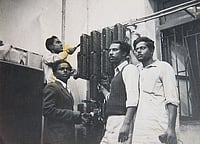Rollouts of 5G, FTTH, and data centres are accelerating the demand of high-quality optical fibre. Indian telcos are planning to lay ~2,00,000 cable kilometers and spend billions of dollars on fibre roll-out in next 2 to 3 years. STL has already made strategic investments for this demand cycle and is playing a pivotal role in this ongoing decade of network creation, both in India and internationally.??
High-Quality Optical Fibre Is The Need Of The Hour To Embrace 5G And FTTH
Outlook spoke to Jitendra Balakrishnan, Chief Technology Officer - Connectivity Solutions, on what is it that India needs to embrace the new network and the opportunities and challenges it holds.

Outlook spoke to Jitendra Balakrishnan, Chief Technology Officer - Connectivity Solutions, on what is it that India needs to embrace the new network and the opportunities and challenges it holds.??
With the launch of 5G and telcos expected to deploy massive amounts of fibre in the next 18 to 24 months, how do you see India embracing the new network? What are the key opportunities for STL and the optical fibre industry at large??
We are seeing a massive push across the globe to lay down telecom infrastructure, and India is no exception. India’s much awaited 5G roll-out has started and will strongly hinge on fibre with telcos planning to lay ~2,00,000 cable kilometers and spend between ~$1.5 Bn to $2.5 Bn1 on fibre roll-out in next 2 to 3 years.? It has been shown that telecom networks are critical to the economy and economic growth. Historically, India has had a telecommunications network based on copper cables, and we still have a much lower penetration of optical fibre than many developed and developing countries. Hence, India is investing aggressively in optical fibre networks, which are essential for modern telecommunications. We have a population which is enthusiastically embracing digital technologies, a telco ecosystem that serves this market, home-grown companies that are developing the entire telecom stack, investments from network creators, and an emerging policy framework that is tying this all together. It is a positive scenario for how we see telecom growth in India.?
STL is one of a handful of companies across the globe with an end-to-end manufacturing capability of optical fibre, optical cables and optical interconnects.? We are now prominent at the forefront of global innovation in this industry and have installed manufacturing capacities that can serve the needs of India along with a strong export market. We are a global company that has emerged from its Indian roots, and have strong local teams in tech, sales and manufacturing across the globe.??
Connecting people to high-speed internet is crucial if we want to make sure that everyone benefits from the digital economy. What types of technologies should telecom providers use to do this???
When we think of telecom networks as today’s consumers, we think of cellular or wireless networks. This delivers the internet to our devices at higher speeds every year. 5G is the latest deployment of this technology which can provide speeds of more than 100 Mbps to a wireless device. Behind these networks, we have a host of technologies that make it all possible. The critical backbone of all networks - wired or wireless - is optical fibre, and we have no alternative to its ability to deliver high connectivity speeds at high data volumes.?
The set of technologies that is on everyone’s mind is on the wireless side. We have hardware, software, network slicing and more. These too are crucial for network performance, coverage, bandwidth and more. Much has been written about this area, but it is important to highlight what is often overlooked - the physical wired network.?
Optical fibre networks are usually invisible to customers and even to telcos who don’t own or operate their own network assets, but this is the place I would start to look at. Building a robust network with a future-proof architecture is critical. It is like designing a city with a well-planned transportation network. If done right, it can make a city thrive; but if done wrong, it can make a city unlivable. Optical fibre networks are the basis of this network architecture and enable wireless and FTTx (Fibre to The Premises) networks to provide excellent coverage and capacity to individual customers.?
Telcos need to lay down optical networks for a lifespan of a couple of decades. This is because of the huge cost and disruption involved in putting down these networks, especially in public areas. Hence, a lot of innovation targets faster and cheaper network deployment that minimized disruptions to everyday life. Examples include the choice of cutting-edge fibre, innovative cable designs, and the use of AI in increasing the efficiency of deployment. These again, are essential technologies for telecom providers to adopt.?
How do different networks, especially wireless (radio/satellite/etc) and wires (optical/copper), complement each other??
In today’s world, wired and wireless networks cannot exist without each other, except in niche applications. The internet is built on long-distance wired networks - almost exclusively optical fibre. These include submarine networks that transport data between continents and terrestrial city-to-city networks. WIthin cities, wired networks also connect one part of the city to the other, and to the data centers that are quickly becoming part of modern networks. Once we get down to local networks, we have an increasing reliance on wireless networks. These include cellular networks, in-building networks, and other examples of last-mile connectivity. We also have satellite-based wireless networks (along with some niche technologies using light beams) that provide coverage to areas that are inaccessible to wired networks, say islands without submarine fibre or areas isolated by inaccessible terrains. Copper is increasingly becoming scarce in telecom networks because fibre is by far a more efficient choice, but copper is far from dead. It is used in cases where power and data need to be delivered together, either in stand-alone form (e.g., some indoor cabling or data centers) or in hybrid copper-fibre cables (e.g., Fibre to the Antenna in mobile networks).?
The best way for a layperson to understand complementary networks is that wired networks provide a global reach while wireless provides ubiquitous coverage. Wired networks enable high-capacity networks that enable increasingly faster wireless technologies, thus allowing consumers an increasing range of applications. Today, most data streams between any two points will pass through a wireless medium at each end, and a wired network (likely optical fibre) in the middle.?
According to you, would be some of the key actions that are needed to strengthen India’s forward-looking network infrastructure?
India has a latent advantage today that we need to capture. We have an extremely low penetration of high-speed networks around the country, have a young population that is hungry for connectivity, and an economy that is both rising and needs a full participation from its human capital. Hence, we need to invest heavily in telecom networks that can leapfrog those in other parts of the world and deliver high-speed connectivity everywhere in the country. We need to enable network architectures that can scale up to the needs of the population and bring a wide range of public and private players to participate in a telecom-enabled economic boom. Many of the actions needed are not just in the technology space, but in public policy and economic decisions. Here are some examples:?
Supporting local industry and ecosystems - Today, the presence of a full telecom technology stack in India provides a significant advantage, and STL is proud to play an anchoring role in the optical network side (i.e. optical fibre, optical cable and interconnects). Campaigns like Make in India are a great start, and we can push it much further by enabling a manufacturing-friendly environment (e.g. clean, green, reliable power, or trade barriers against anti-competitive practices like dumping). There has been a similar push from the government on the start-up ecosystem, which is creating some very interesting ideas - there is a lot of work to be done to support this ecosystem.??
National policies that enable futuristic telecom networks - India has a robust telecom policy and there is always much to be done in such a dynamic field. Some examples include infrastructure-sharing that allow telcos to access more customers with a healthy competition for subscribers, or regulating telecom as a utility (like power, water, or sewage) that can enable better network rollouts. To illustrate the last example, we see far more cable cuts in India than other parts of the world due to uncoordinated network deployment, digging for roads and so on. This creates a sub-optimal network that needs frequent repairs, and it is also hard to invest in a long-term, high-quality network unless it can be protected as a utility.??
Enabling a high-quality low-cost network - India already has one of the lowest data rates in the world, and this is a great thing for consumers. However, it may also lead to an inability of telcos to invest in networks. The high cost of spectrum combined with low ARPUs ranging from INR 130 to INR 170 leaves relatively little to pour into physical infrastructure, as seen by the relatively lackluster 3G (and even 4G roll-outs). For 5G networks, we will need a lot of investment in physical infrastructure, and we need to figure out how to make this affordable for telecom providers without loading consumers with high costs.??
Such actions will truly transform connectivity in India, which has in turn been proven to have a direct positive impact on economic growth and the overall well-being of the population.





















